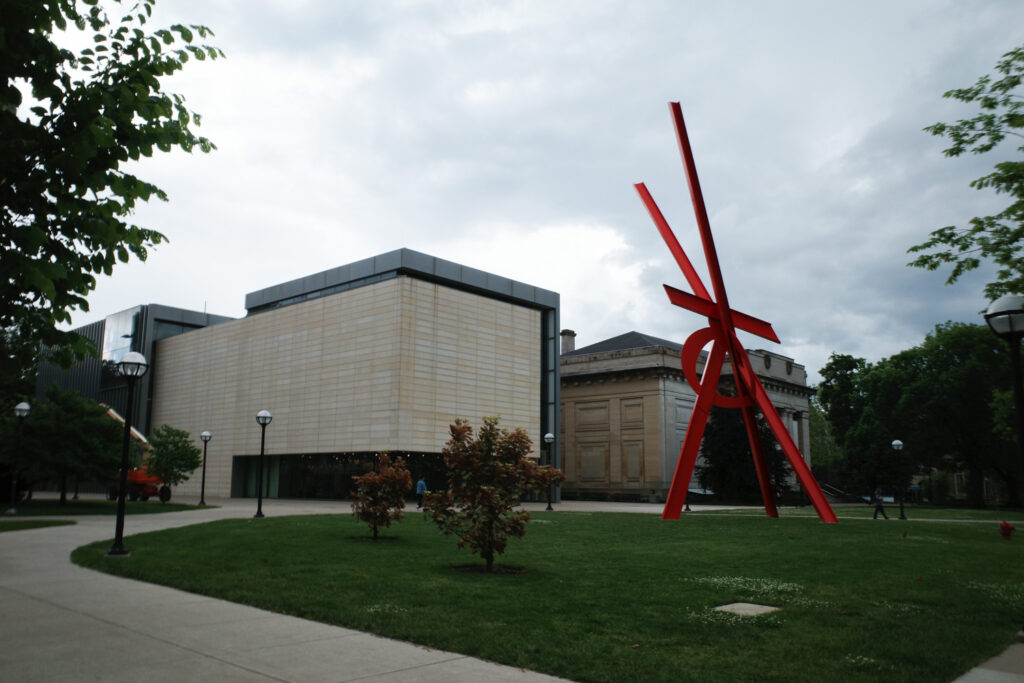Grand Rapids — The Grand Rapids Art Museum put up a slew of new exhibitions in the early summer: Detroit artist Mario Moore’s Revolutionary Times; The Outwin: American Portraiture Today, a national juried exhibition traveling the country; and Jess T. Dugan’s Look at me like you love me.
Yet again, the slate unveils the GRAM’s true intention—to wokescold you into submission. To lecture you in the most narrow, pandering, parochial ways.
These shows barely scratch the surface, even of the complex and ever-shifting web of progressive identity politics they’re based on. At most, the shows make a ham-fisted attempt at “visibility,” showcasing imagery of marginalized groups as a crass form of virtue signaling.
Mario Moore’s exhibition “celebrates Black power and resistance,” according to the GRAM. Large, traditional-style oil paintings of contemporary and historical black figures, sometimes engaging with artifacts and episodes of American history. They do feel celebratory, but not at all revelatory. There’s nothing deeper here than a pompous posturing of visual archetypes of American blackness.

The paintings are technically well-executed figurative portraits. A black man striking a pose in a blue jacket and fedora. A bespectacled black man observing a scene from the Civil War. A group of dressed-up black women posing around a table. A black couple reclining at the beach. Black pride, black leisure, blackness. Visibility, the curators might say, visibility for black identity. In other words, race fetishism. If the artist were white, this work would be burned for being “cultural appropriation” in the most narrow sense.
Dugan’s show graces the exterior of the GRAM building. Elegant, ornate photographs of diverse figures. Top surgery scars, makeup on a masculine figure, same-sex couples locked in embrace. The message is pretty clear, a celebration of queer (non-straight) identity. Dugan, in fairness, steers away from overt politicization, claiming, “There are elements of gender and sexuality in Look at me like you love me, but it’s more about being a person, what it means to be alive, and what it means to connect with other people.” Sure, fine, that’s all well and good, but the curators surely don’t see it that way.

The choice of subjects, those with visually queer identities, is deliberate, if not by the artist, then by the curators. Their placement is no coincidence either: on the most visible exterior wall of the GRAM, right next to the Pride and BLM flags hanging inside the glass window panes. Visibility is again the intent here, taking all the visual artifacts of these queer identities and putting them in a public space so people see them. The theory goes, if the invisible is made visible, it will lead to acceptance and celebration.
The irony is, in celebrating the marginalized, the ideologues have made them normal. The Progress Pride flag might as well signify the new state religion, considering it hangs outside all these major institutions. Photos of queer identity, all the scars and bad haircuts, are shoved in our face daily, functioning more as propaganda than as a rebellion against some view of an oppressive straight culture. They are, once again, fetishized.
The Outwin is a juried portrait exhibition traveling around the nation’s museums. No surprises there, either. Portraits in various forms—photographs, paintings, textiles, sculpture, video. The best one was an hauntingly abstract portrait of the artist’s mother, made with nicotine stains on an off-white canvas. It drew me in before I even realized what it was. The brown stains of cigarette smoke were fluid, organic, all too real. No claims toward race here, just something far more human, the lingering presence of absence.

The other pieces were entirely in-your-face lectures about racial identity. You could barely breathe in there with all the smugness. A video of a black woman dancing and talking about being a black woman. A painting of a black woman in a spacesuit on another planet. Black children looking out a window. A photo of a short-haired lesbian couple embracing. A painting of an elderly Mexican couple. A collage of a black woman with her hair wrapped up in colorful cloth. A painting of an old white lady, her body sagging. And the nicotine-painting. Every other racial, sexual, gender identity was celebrated, while white people were shown decaying.

A photograph of a young woman, an orange sunset hue across her face. A truly beautiful photograph, it stood on its own. The wall text? Honest at first—photographer Grade Solomon “embarked on a road trip in December 2020, traveling through Texas, where he took this photograph. Recognizing the interplay of the early evening’s light, shadow, and color, Solomon provides a temporal specificity to the exploratory journey by drawing on the lonstanding [sic] tradition of road trip photography in the United States.”

Have to laugh at the typo. They couldn’t be bothered to spell check the wall text for a national exhibition? Otherwise, it’s art speak for “he took a cool sunset photo of a pretty girl on a road trip.” Of course, it needed a pandering blurb at the end to pay homage to racial visibility: “Solomon also connected with the sitter on a personal level; the two discussed their lives as biracial Asians at a moment when anti-Asian hate was on the rise.”
You can’t simply make a beautiful photograph of a beautiful person and get it in the museum. The photographer and the subject are both half-Asian, so the racial politics get written in, advantageously for the artist. It doesn’t matter that this ideology isn’t explicitly present in the photo, it suffices to simply make visible a minority person and tie it to the politics with the wall text.
Visibility—that’s the buzzword here, visibility for the sacred cows of the secular religion, visibility for anyone with marginalized identity. Why? To atone, and to educate. The curatorial mindset here is two-fold. These groups have been historically absent from museum settings, so they atone, confessing sins and doing penance. The duty is to educate the public, to do exhibitions that will shape the minds of viewers into beautiful compassion blasting machines.
Not just the adult public, but the children as well. The GRAM even has a children’s education wing right off the main floor, a creepy space filled with toys and modern art. During my visit, there must have been an entire elementary school on the premises. Teachers walked the halls with gaggles of little students behind them, excited for their big field trip to the museum. All of them white, I might add.

The only images of white people in the GRAM are the medieval paintings in the permanent collection and a few pre-modern paintings. The entire contemporary slate at the moment is, very intentionally, portraits of anyone who isn’t straight and white. White schoolchildren traipsing the halls? You belong to the past.
I don’t think that visibility, in the end, matters much. It’d be absurd to apply the logic of racial quotas to museum settings; everyone represented, no one offended. But the curatorial excess is even more extreme here, beyond affirmative action. Woke curators have fetishized racial identity to the point where it’s become a trope.
Museum curators in their comfy offices aren’t combatting racism, or even the very idea of race. They’re encouraging it, solidifying it, fetishizing it. Self-indulgently employing it to promote their own careers. Scores of white female curators fixated on the other, the noble savage, ideas they love to criticize, but so obviously fall right into. The obsession with marginalized identity only thinly masks their contempt.
This is bad art, and even worse curating. Lazy and cravenly self-indulgent. Beating you over the head with a chime that rings out only one note. The most facile ideal of progressive race-baiting: that white people belong to history, and the future to everyone else.
Bobby Mars is an artist, alter ego, and former art professor. Follow him on X @bobby_on_mars.




